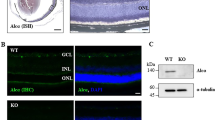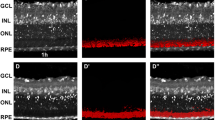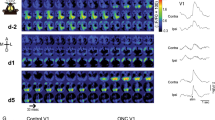Abstract
In this protocol, we describe the imaging of single axons in the rat optic nerve in vivo. Axons are labeled through the intravitreal injection of adeno-associated viral vectors (AAVs) expressing a fluorophore (duration of the procedure ∼1 h). Two weeks after intravitreal injection, the optic nerve is surgically exposed (duration ∼1 h) and labeled axons are imaged with an epifluorescence microscope either for up to 8 h or repetitively on the following days. Additionally, intravitreal injection of calcium-sensitive dyes allows for imaging of intra-axonal calcium kinetics. This procedure enables the analysis of the morphological changes of degenerating axons in the optic nerve in different lesion paradigms, such as optic nerve crush, axotomy or pin lesion. Furthermore, the effects of pharmacological manipulations on axonal stability and axonal calcium kinetics in axons of the central nervous system can be studied in vivo.
This is a preview of subscription content, access via your institution
Access options
Subscribe to this journal
Receive 12 print issues and online access
$259.00 per year
only $21.58 per issue
Buy this article
- Purchase on Springer Link
- Instant access to full article PDF
Prices may be subject to local taxes which are calculated during checkout





Similar content being viewed by others
References
Maier, K. et al. Multiple neuroprotective mechanisms of minocycline in autoimmune CNS inflammation. Neurobiol. Dis. 25, 514–525 (2007).
Wang, A.L., Yuan, M. & Neufeld, A.H. Degeneration of neuronal cell bodies following axonal injury in Wld(S) mice. J. Neurosci. Res. 84, 1799–1807 (2006).
Ohlsson, M., Mattsson, P. & Svensson, M. A temporal study of axonal degeneration and glial scar formation following a standardized crush injury of the optic nerve in the adult rat. Restor. Neurol. Neurosci. 22, 1–10 (2004).
Wilkins, A. et al. Slowly progressive axonal degeneration in a rat model of chronic, nonimmune-mediated demyelination. J. Neuropathol. Exp. Neurol. 69, 1256–1269 (2010).
Munemasa, Y., Kitaoka, Y., Kuribayashi, J. & Ueno, S. Modulation of mitochondria in the axon and soma of retinal ganglion cells in a rat glaucoma model. J. Neurochem. 115, 1508–1519 (2010).
Carelli, V. et al. Retinal ganglion cell neurodegeneration in mitochondrial inherited disorders. Biochim. Biophys. Acta. 1787, 518–528 (2009).
Coleman, M. Axon degeneration mechanisms: commonality amid diversity. Nat. Rev. Neurosci. 6, 889–898 (2005).
Fischer, L.R. et al. Amyotrophic lateral sclerosis is a distal axonopathy: evidence in mice and man. Exp. Neurol. 185, 232–240 (2004).
Li, H., Li, S.H., Yu, Z.X., Shelbourne, P. & Li, X.J. Huntingtin aggregate-associated axonal degeneration is an early pathological event in Huntington's disease mice. J. Neurosci. 21, 8473–8481 (2001).
Ohki, K., Chung, S., Ch'ng, Y.H., Kara, P. & Reid, R.C. Functional imaging with cellular resolution reveals precise micro-architecture in visual cortex. Nature 433, 597–603 (2005).
Lindvere, L., Dorr, A. & Stefanovic, B. Two-photon fluorescence microscopy of cerebral hemodynamics. Cold Spring Harb. Protoc. published online, doi:10.1101/pdb.prot5494 (1 September 2010).
Orringer, D.A. et al. A technical description of the brain tumor window model: an in vivo model for the evaluation of intraoperative contrast agents. Acta Neurochir. Suppl. 109, 259–263 (2011).
Misgeld, T., Nikic, I. & Kerschensteiner, M. In vivo imaging of single axons in the mouse spinal cord. Nat. Protoc. 2, 263–268 (2007).
Cordeiro, M.F. et al. Real-time imaging of single nerve cell apoptosis in retinal neurodegeneration. Proc. Natl. Acad. Sci. USA 101, 13352–13356 (2004).
Kanamori, A., Catrinescu, M.M., Traistaru, M., Beaubien, R. & Levin, L.A. In vivo imaging of retinal ganglion cell axons within the nerve fiber layer. Invest. Ophthalmol. Vis. Sci. 51, 2011–2018 (2010).
Leung, C.K. et al. Long-term in vivo imaging and measurement of dendritic shrinkage of retinal ganglion cells. Invest. Ophthalmol. Vis. Sci. 52, 1539–1547 (2011).
Knoferle, J. et al. Mechanisms of acute axonal degeneration in the optic nerve in vivo. Proc. Natl. Acad. Sci. USA 107, 6064–6069 (2010).
Martin, K.R., Klein, R.L. & Quigley, H.A. Gene delivery to the eye using adeno-associated viral vectors. Methods 28, 267–275 (2002).
Choi, V.W., Asokan, A., Haberman, R.A. & Samulski, R.J. Production of recombinant adeno-associated viral vectors and use for in vitro and in vivo administration. Curr. Protoc. Neurosci. 35, 4.17.1–4.17.30 (2006).
Acknowledgements
We thank L. Barski for excellent technical assistance, R. Günther for help with photographing and J.L. Welsh for comments on the manuscript. J.C.K., M.B. and P.L. are funded by the Deutsche Forschungsgemeinschaft (DFG).
Author information
Authors and Affiliations
Contributions
J.C.K., J.K. and L.T. performed the experiments and optimized the procedure. U.M. and J.C.K. produced the viral vectors. P.L., J.K. and J.C.K. designed the experiments. P.L. and M.B. supervised the work. J.C.K. wrote the manuscript.
Corresponding authors
Ethics declarations
Competing interests
The authors declare no competing financial interests.
Supplementary information
Supplementary Fig. 1
Intravitreal injection of AAV. (a) The eyelid of the rat is retracted to both sides with the right hand. Then the eye bulb is fixed from the nasal side with thumb and index of the left hand. (b+c) A Hamilton syringe is inserted with the right hand 2 mm behind the inferior temporal limbus directing towards the upper nasal side. (d) The needle is carefully pushed forward to the upper nasal quadrant of the retina under direct visual control through the operating microscope. 4-5 µl of AAV are slowly injected over 1 min and the needle is then slowly retracted. All animals were treated according to the regulations of the local animal research council and legislation of the State of Lower Saxony. (PDF 156 kb)
Supplementary Fig. 2
Optic nerve crush. The first steps are performed as depicted in Figure 2. (a) After the optic nerve (arrow) is exposed, the dura is incised longitudinally (black line) in between the ophthalmic blood vessels without damaging the vessels. (c-d) The dura is then carefully retracted to both sides of the incision together with the ophthalmic blood vessels until the nerve is completely exposed. (e) A 10-0 suture is made around the optic nerve at a distance of 2 mm proximal to the eye bulb. (f) After imaging the unlesioned nerve, the suture is closed under the imaging microscope and left in-situ. (g) When live imaging has been finished, the suture is removed without damaging the nerve. (h) If recovery of the animal and later re-imaging of the optic nerve are planned, the dura is closed around the optic nerve, all orbital structures are put back into situ and the skin is sutured. Note that the ophthalmic blood vessels that were moved aside for imaging look still vital afterwards (h). All animals were treated according to the regulations of the local animal research council and legislation of the State of Lower Saxony. (PDF 737 kb)
Supplementary Fig. 3
Rat positioning setup. (a,b) The custom-made rat positioning setup comprises a commercial rat head holder (3) that is stably fixed on a rotatable plastic bar (symbolized by the gray line in (b)). The body of the rat is positioned on a bigger board (1) which is also fixed on the rotatable bar. This enables rotation of the whole animal of up to 30° in both directions as it is needed for exposure and imaging of the optic nerve in-situ. The bar is attached to a bigger plastic plate (2) which can be screwed to a modified microscope stage using pre-defined screw holes (dark arrows). In (a) the directions that need to be freely adjusted are marked with white arrows pointing in the respective directions. The asterisk marks a small paper box that is used to hold the hook which is inserted in the superior rectus muscle to fix the eye bulb. This elevated position is important to avoid fluid leaking out of the orbit along the hook. (PDF 321 kb)
Rights and permissions
About this article
Cite this article
Koch, J., Knöferle, J., Tönges, L. et al. Imaging of rat optic nerve axons in vivo. Nat Protoc 6, 1887–1896 (2011). https://doi.org/10.1038/nprot.2011.403
Published:
Issue Date:
DOI: https://doi.org/10.1038/nprot.2011.403
Comments
By submitting a comment you agree to abide by our Terms and Community Guidelines. If you find something abusive or that does not comply with our terms or guidelines please flag it as inappropriate.



